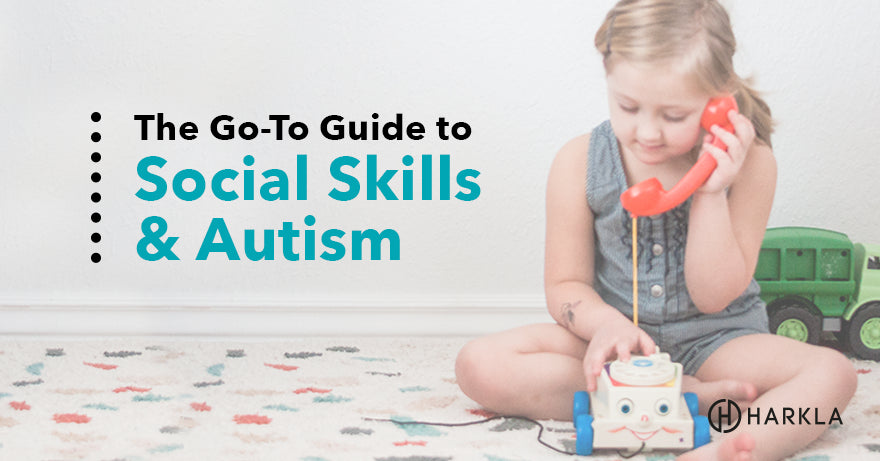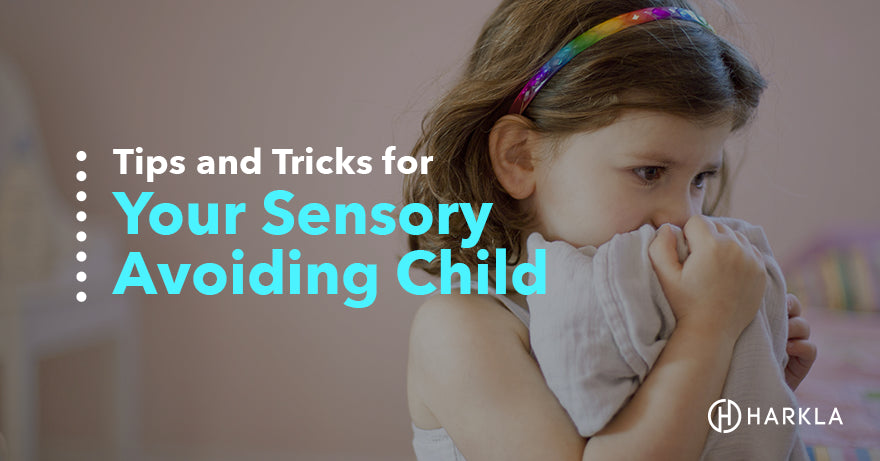Your Cart is Empty

Autism spectrum disorder (ASD) is a developmental disorder that impacts areas such as behavior, communication, daily living skills, and social skills. Many children with autism also engage in repetitive and/or restrictive behavior. They may repeat certain words or phrases, have sensitivities to certain sensory stimuli in the environment, and have strong reactions to changes in routine or schedule.
According to the most up-to-date research, ASD affects approximately 1 in 40 children in the United States. The symptoms of autism generally appear within the first two years of a child’s life, which is why autism is referred to as a “developmental disorder.”
The term autism spectrum refers to the spectrum of symptoms often associated with the disorder. For example, some children experience difficulties in all symptom areas, while some may primarily struggle with social/communication skills.

It is important to note that all children with autism show some type of delay in the area of social and communication skills.
The severity is very different across all children with ASD. For example, one child may be non-verbal and unable to communicate without the use of aids, while another child may have difficulties with skills such as using appropriate eye contact in conversations.
In this article, we will examine social skills in children with autism. We will also discuss therapeutic programs that can help children with autism improve their social skills.
In May of 2013, the American Psychiatric Association published an updated version of the Diagnosis and Statistical Manual of Mental Disorders, commonly referred to as the DSM. In the DSM-5, several diagnoses were updated and some were added, as a way to provide healthcare professionals with new guidelines for diagnosing mental health disorders. A new diagnostic category was added, called Social (Pragmatic) Communication Disorder, commonly referred to as SCD. SCD involves problems with understanding the pragmatics of communication.
The term pragmatics refers to the ability to use language in the proper context. Below are some examples of the term pragmatics and how children with SCD might have difficulty with pragmatics.
Recent research has shown that children who previously received a diagnosis of autism, would now likely receive a diagnosis of SCD instead, based upon the updated criteria.
The main question many parents still have is, how is Social Communication Disorder different from Autism Spectrum Disorder?
A full diagnostic assessment is needed to differentiate and properly diagnose children with ASD and SCD. Often, a speech-language pathologist is now a part of autism diagnostic teams, which is beneficial as they have further training in social and communication disorders.
Children who are diagnosed with an ASD also have social/communication difficulties, will also present with the characteristics of engaging in restricted and/or repetitive behaviors. For example, children with ASD will commonly become overloaded and have strong reactions to certain sensory input (i.e., loud noises, busy places), while children with SCD will solely have difficulties in the areas of social and communication skills.
Children with autism or SCD often receive many types of therapy and skills training to address social skills deficits, as well as the other medical and behavioral difficulties they may experience.
They may receive services in the areas of psychiatry, psychology, mental health counseling, occupational therapy, and speech therapy. Behavioral therapies such as counseling, occupational therapy, and speech therapy are often the ones to address social skills in children with autism or SCD. We will review some of the most common therapeutic interventions used by these professions to address social skills.

Oftentimes, children with social skills deficits learn best by practicing these skills in real-life situations, or as close to real-life as possible. This has to do with the way their brains process context. For this reason, many children with ASD or SCD benefit from social skills groups, where they can directly practice skills with other children.
Many social skills groups will target specific skills at one time and use creative ways to help children practice these skills. For example, one common modality is teaching about eye contact and turn-taking. The therapist may then facilitate a board game, where the children can practice using proper eye contact and taking appropriate turns. Other skills addressed in social skills groups might include using appropriate greetings in conversation, practicing how to make a request or a command, using appropriate facial expressions and gestures in conversation, standing at an appropriate distance during a conversation, etc.
Similar to social skills groups, video modeling provides a way for children to visually see and examine social skills, which leads to better carry-over of skills. There are two types of video modeling that are commonly used. In the first, the child is video recorded (with parental consent) during a therapy session. Then, together with their therapist, the child and therapist watch the video recording and the therapist uses this as a guide to address skills such as eye contact and conversation pragmatics.
In the second type, the child watches recordings of others engaging in appropriate and not appropriate social interactions. Again, the therapist would use this as a framework to address any specific skills the child could improve upon. In both of these scenarios, the child is given real-life, tangible examples of appropriate and non-appropriate social skills, which is beneficial for children with an ASD or SCD.
Children with autism often have specific social skills they struggle with. The skill deficit may be very context-specific. For example, a child might have difficulty raising his hand in the classroom and instead might blurt out answers. In these instances, a social story or a social script is often used to help with outlining the appropriate steps in a situation.
Children with autism are typically visual learners who learn best from concrete, direct steps, which is why social stories and social scripts work well to help teach social skills. Generally, these tools will include pictures and words and be very specific to the child’s own real-life routine, to promote carry-over.
Below are links to some examples of social stories and social scripts:
Getting an allergy test at the doctor
Though group practice is often most beneficial for children with autism or SCD, many therapists will also work with children one-on-one to learn about and practice social skills. There is a benefit to this as it is a non-threatening way to introduce children to social skills. It helps develop trust between the therapist and child and allows the child to ask questions in a safe place.
There are many social skills programs on the market today geared towards children with autism/SCD and they are often research-based. Below is a review of some of the most common social skills programs used and a brief description of how they might be helpful.
Superflex: A Superhero Social Thinking Curriculum: This program is used typically with elementary school children and includes a set curriculum, with picture books, for introducing children to a variety of social skills and ways to improve social skills. This curriculum uses a superhero as the main character, which is a playful way to address this topic with children. You can learn more about the program here.
PEERS Curriculum for Adolescents: This curriculum is a research-based manual to address social skills in older children and adolescents with autism. It is broken down by skill area and considers many of the social skills that adolescents must utilize in today’s world. For example, using electronic communication, choosing friends, handling teasing and cyber-bullying, etc. The program is linked here if you’d like to learn more.
The Zones of Regulation: This program is primarily used to help children learn self-regulation skills. However, it also ties in social skills. The program can be used and adapted for children aged preschool through high school and uses four colored “zones” to help children learn about their emotions, feelings, behaviors, and how their behaviors impact those around them. Here is a link to this program.
The interventions discussed above are those typically used by health professionals, such as psychologists, mental health therapists, occupational therapists, and speech therapists to help address social skills for children with autism and/or SCD.

Your child’s therapist will likely discuss ways to further incorporate and reinforce these skills in the home setting. The curriculums discussed above each have a home programming component as well. Below are some ways to further help your child practice social skills at home:
Children diagnosed with autism all have difficulties with some aspects of social skills. Each child will have their own unique social skills needs and interventions such as video modeling, social skills groups, social skills curriculums, social stories and scripts, and carry-over and practice of skills at home can all be beneficial in supporting your child.
As always, it is best to have a formalized assessment completed, preferably with a team from multiple disciplines, such as psychology, occupational therapy, and speech-language therapy. The results of a formal assessment can help to determine best which interventions will be the most helpful for your child and your family.
References
Kogan et al. (2018). The prevalence of parent-reported autism spectrum disorder among US Children. Journal of Pediatrics, 142(6).
Wang, P. & Spillane, A. (2009). Evidence-based social skills interventions for children with autism: A meta-analysis. Education and Training in Developmental Disabilities, 318.
Thank you for this informative article. You mention some ways to help elementary students and adolescents. What suggestions do you have for toddlers?? My grandsons (twin boys- fraternal) both seem to be on the spectrum. One presents with behaviors more intune with SCD. the other may be more on the spectrum.
Please advise. Thank you!
I have been working at a therapeutic riding center where I live, and we work with quite a few autistic kids! I think everything that this article includes is wonderful and most definitely helps improve social skills! I just wanted to offer a bit of what I’ve noticed as I’ve worked closely with these kids. At the riding center we work at, we use lots of animals in our activities. These kids seem to see animals as a kind on non-judgemental outlook where they can communicate through the animals to other people. I’ve seen lots of spontaneous speech as well as polite behavior come out as a result of these animals. Also, riding horses really does help! By allowing the child to recognize that the correct cues given to a horse from the child causes the horse to do what he/she wants them to do, the child starts to integrate those skills into their real lives. Overall though, the creating of a lowstress environment is one of the most beneficial parts of what we do! These are just my own thoughts, and they may not even be scientifically correct, but I have seen improvements.
Hi Jackie,
We are really glad to hear that you’ve found this article helpful! Thanks for letting us know.
All the best to you,
Nicole
Harkla Happiness Ninja
My son does not have any official or medical diagnose yet but he shows some speech delays and behaviors which which makes me think that he may be autistic or something related to it. I want to thank all those fantastic information that besides clarifying, educate and help parents and mothers as well as me in search of answers to know how to live and deal with their needs. Gratitude! Thanks
Comments will be approved before showing up.


Nicole
April 24, 2019
Hi Marianela,
You can use some of the tips in this article by modifying for the level/age of the child. For example, if the child likes to watch TV or listen to stories, use ones that are age-appropriate and point out specific instances where there is a positive example of social behavior. Modeling appropriate behaviors and reinforcing positive behaviors will also help. We highly recommend talking to a BCBA, SLP, or OT to learn more.
All the best!
Nicole
Harkla